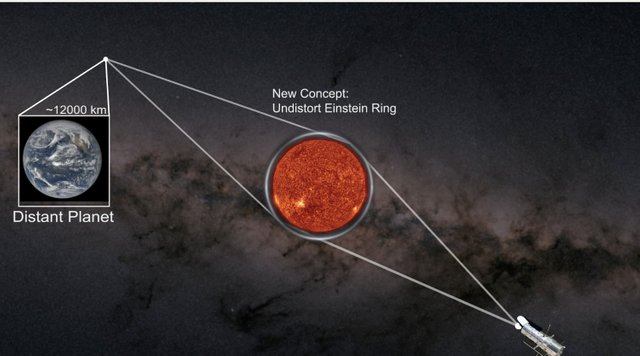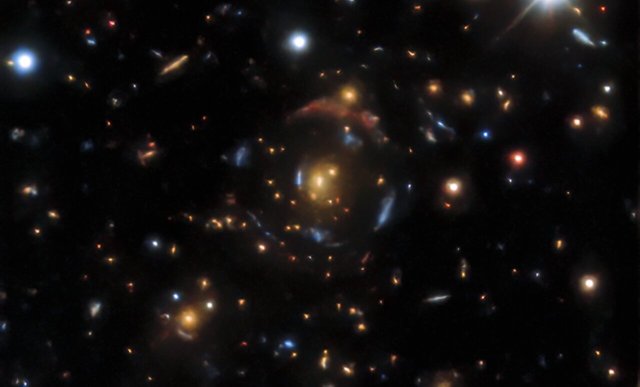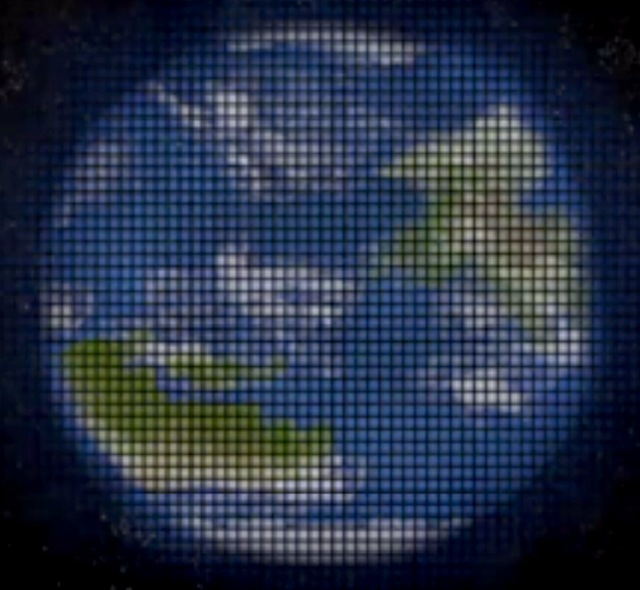New concept of a gravity telescope that could image exoplanets/Nuevo concepto de un telescopio de gravedad que podría obtener imágenes de exoplanetas

Source
Since the first exoplanet was discovered at the beginning of the 90s, nearly 5,000 new planets orbiting other stars have already been discovered, but the information obtained from them is very scarce and does not contribute much, now a group of scientists intends to reach see exoplanets as sharply as we see those in our solar system based on gravitational lensing.
Desde que al principio de los 90 se descubrió el primer exoplaneta ya se han descubierto cerca de 5.000 nuevos planetas orbitando otras estrellas, pero la información que se obtiene de ellos es muy escasa que no aporta gran cosa, ahora un grupo de científicos pretende llegar a ver los exoplanetas con la nitidez que vemos los de nuestro sistema solar basándose en las lentes gravitacionales.
The concept of gravitational lenses arises from the theory of general relativity proposed by Einstein, according to this theory the gravity of large stellar objects deflect the path of light allowing distant objects behind that object to be seen, which it was tested by Sir Arthur Eddington during a solar eclipse in 1919.
El concepto de lentes gravitacionales surge a partir de la teoría de la relatividad general propuesto por Einstein, según esta teoría la gravedad de los objetos estelares de gran tamaño desvían la trayectoria de la luz permitiendo ver los objetos lejanos que están tras ese objeto, cosa que fue probada por Arthur Eddington durante un eclipse solar en 1919.

Source
Nowadays if we want to image an exoplanet with the mentioned resolution, we would need a telescope 20 times wider than the Earth while using the sun's gravity as a telescope, a Hubble-sized one in combination with the sun's gravitational lens would suffice to get high-quality images.
Hoy en día si queremos obtener imágenes de un exoplaneta con la resolución mencionada, necesitaríamos un telescopio 20 veces más ancho que la Tierra mientras que usando la gravedad del sol como un telescopio, bastaría con uno del tamaño de Hubble en combinación con la lente gravitacional solar para conseguir imágenes de alta calidad.
Through this new concept, the researchers describe a way to manipulate solar gravitational lenses by placing a telescope, the sun and the exoplanet in line, in this way they will be able to use the gravitational field of the sun to increase the light of the exoplanet taking advantage of the curvature of space-time which allows you to see distant objects.
Mediante este nuevo concepto los investigadores describen una forma de manipular las lentes gravitacionales solares colocando en línea un telescopio, el sol y el exoplaneta, de este modo podrán usar el campo gravitacional del sol para aumentar la luz del exoplaneta aprovechando la curvatura del espacio-tiempo que permite ver objetos lejanos.

Source
This technology will allow us to investigate the dynamics of the atmospheres of the planets, the distribution of clouds and even characteristics of their surface such as the presence of continents and oceans, which allows us to know whether or not there is life on these exoplanets, which until now was something unthinkable.
Esta tecnología permitirá investigar la dinámica de las atmósferas de los planetas, la distribución de las nubes e incluso características de su superficie como la presencia de continentes y océanos, cosa que nos permite saber si existe o no vida en estos exoplanetas lo que hasta ahora era algo impensable.
It will be quite another thing to be able to reach them taking into account that, excluding those of the solar system, the closest planets are found in Alpha Centauri, that is, at a distance of 4.2 light years, or what is the same, at almost 40 trillions of kilometers from us what today we are unable even to imagine.
Otra cosa muy distinta será poder llegar hasta ellos teniendo en cuenta que, excluyendo los del sistema solar, los planetas más cercanos se encuentran en Alpha Centauri es decir a una distancia de 4,2 años luz o lo que es lo mismo, a casi 40 billones de kilómetros de nosotros lo que hoy por hoy somos incapaces incluso de imaginar.
More Information/Más información
https://www.nextbigfuture.com/2022/05/a-gravity-telescope-that-could-image-exoplanets.html
Hola @mauromar, ya me imagino la cara de los científicos cuando encuentren lo que andas buscando.

The planet earth is so decomposed that we "prefer" to entertain ourselves in the mysteries of the universe and thus not even be aware of what its end will be like, which is very, very close.
Nice technique to examine distant objects